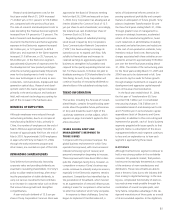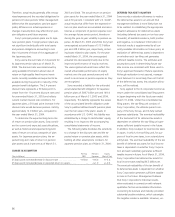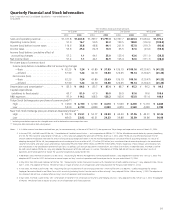Sony 2004 Annual Report Download - page 89
Download and view the complete annual report
Please find page 89 of the 2004 Sony annual report below. You can navigate through the pages in the report by either clicking on the pages listed below, or by using the keyword search tool below to find specific information within the annual report.
87
der recent conditions, management considers
that it is possible that Sony Corporation’s fu-
ture results may yield sufficient negative evi-
dence to support the conclusion that it is more
likely than not that Sony Corporation will not
realize the tax benefit of all these deferred tax
assets. If this is the case, subject to review of
relevant qualitative factors and uncertainties,
Sony may establish a valuation allowance
against part or all of the deferred tax assets of
Sony Corporation that would be charged to
income as an increase in tax expense.
As of March 31, 2004, the U.S. subsidiaries
of Sony had a valuation allowance of 81.0
billion yen against deferred tax assets for
federal and certain state taxes. Since the U.S.
subsidiaries did not have a sufficient history of
taxable income at this time to conclude that it
is more likely than not that the tax benefit from
these deferred tax assets would be realized, a
valuation allowance was established. Manage-
ment believes this lack of sufficient earnings
history, when evaluated in connection with
relevant qualitative factors and uncertainties
concerning the U.S. subsidiaries’ businesses
and industries, provided substantial negative
evidence, which outweighs any positive evi-
dence, regarding the eventual realizability of
the tax benefit of the deferred tax assets as of
March 31, 2004. However, under recent
conditions, management considers that it is
possible that the U.S. subsidiaries’ future
results may yield sufficient positive evidence to
support the conclusion that it is more likely
than not that the U.S. subsidiaries could realize
the tax benefit of these deferred tax assets and
that such a conclusion may be reached as early
as during the fiscal year ending March 31,
2005. If this is the case, subject to review of
relevant qualitative factors and uncertainties,
Sony may reverse part or all of the valuation
allowance that would be recognized into
income as a reduction to tax expense.
FILM ACCOUNTING
An aspect of film accounting that requires the
exercise of judgment relates to the process of
estimating the total revenues to be received
throughout a film’s life cycle. Such estimate of
a film’s ultimate revenue is important for two
reasons. First, while a film is being produced
and the related costs are being capitalized, it is
necessary for management to estimate the
ultimate revenue, less additional costs to be
incurred, including exploitation costs which are
expensed as incurred, in order to determine
whether the value of a film has been impaired
and thus requires an immediate write off of
unrecoverable film costs. Second, the amount
of film costs recognized as cost of sales for a
given film as it is exhibited in various markets
throughout its life cycle is based upon the
proportion that current period actual revenues
bear to the estimated ultimate total revenues.
Management bases its estimates of ultimate
revenue for each film on several factors includ-
ing the historical performance of similar genre
films, the star power of the lead actors and
actresses, the expected number of theaters at
which the film will be released, anticipated
performance in the home entertainment,
television and other ancillary markets, and
agreements for future sales. Management
updates such estimates based on the actual
results to date of each film. For example, a film
that has resulted in lower than expected theat-
rical revenues in its initial weeks of release
would generally have its theatrical, home video
and distribution ultimate revenues adjusted
downward; a failure to do so would result in
the understatement of amortized film costs
for the period. Since the total film cost to be
amortized for a given film is fixed, the estimate
of ultimate revenues impacts only the timing
of film cost amortization.
FUTURE INSURANCE POLICY BENEFITS
Long-term liabilities for future policy benefits
are established in amounts adequate to meet
the estimated future obligations of policies in
force. These liabilities are computed by the net
level premium method based upon estimates
as to future investment yield, mortality, mor-
bidity, withdrawals and other factors. Future
policy benefits are computed using interest
rates ranging from approximately 1.00 percent
to 5.50 percent. Mortality, morbidity and with-
drawal assumptions for all policies are based
on either the life insurance subsidiary’s own
experience or various actuarial tables. Generally
these assumptions are “locked-in” upon the
issuance of new insurance. While management
believes that the assumptions used are appro-
priate, differences in actual experience or
changes in assumptions may affect Sony’s
future insurance policy benefits.
For a summary of Sony’s significant account-
ing policies, including the critical accounting
policies discussed above, please see Note 2 of
Notes to the Consolidated Financial Statements.
RECENTLY ADOPTED ACCOUNTING
STANDARDS
EMPLOYERS’ DISCLOSURES ABOUT PENSIONS
AND OTHER POSTRETIREMENT BENEFITS
In December 2003, the FASB revised Statement
of Financial Accounting Standards (“FAS”)
No. 132, “Employers’ Disclosures about Pensions
and Other Postretirement Benefits”, an amend-
ment of FAS No. 87, “Employers’ Accounting
for Pensions”, FAS No. 88, “Employers’
Accounting for Settlements and Curtailments of
Defined Benefit Pension Plans and for Termina-
tion Benefits”, and FAS No. 106, “Employers’
Accounting for Postretirement Benefits Other
Than Pensions”. The new FAS No. 132 revised
employers’ disclosures about pension plans and
other postretirement benefit plans. It did not
change the measurement or recognition of
those plans required by FAS No. 87, 88 and
106. While retaining the disclosure require-
ments of FAS No. 132, the new FAS No. 132
requires additional disclosures about assets,
obligations, cash flows, and net periodic benefit
costs of defined benefit plans and other defined
benefit postretirement plans. The provisions of
the new FAS No. 132 are generally effective for
financial statements with fiscal years ending
after December 15, 2003, excluding the disclo-
sure of certain information about foreign plans,
which shall be effective for fiscal years ending
after June 15, 2004. In accordance with the
transition provisions of the new FAS No. 132,
the disclosure provisions have been adopted in
the consolidated financial statements.
























